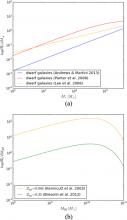
Abstract
We investigate the contribution of outer HI disks to the observable population of merging black hole binaries. Like dwarf galaxies, the outer HI disks of spirals have low star formation rates and lower metallicities than the inner disks of spirals. Since low-metallicity star formation can produce more detectable compact binaries than typical star formation, the environments in the outskirts of spiral galaxies may be conducive to producing a rich population of massive binary black holes. We consider here both detailed controlled simulations of spirals and cosmological simulations, as well as the current range of observed values for metallicity and star formation in outer disks. We find that outer HI disks contribute at least as much as dwarf galaxies do to the observed LIGO/Virgo detection rates. Identifying the host galaxies of merging massive black holes should provide constraints on cosmological parameters and insights into the formation channels of binary mergers.